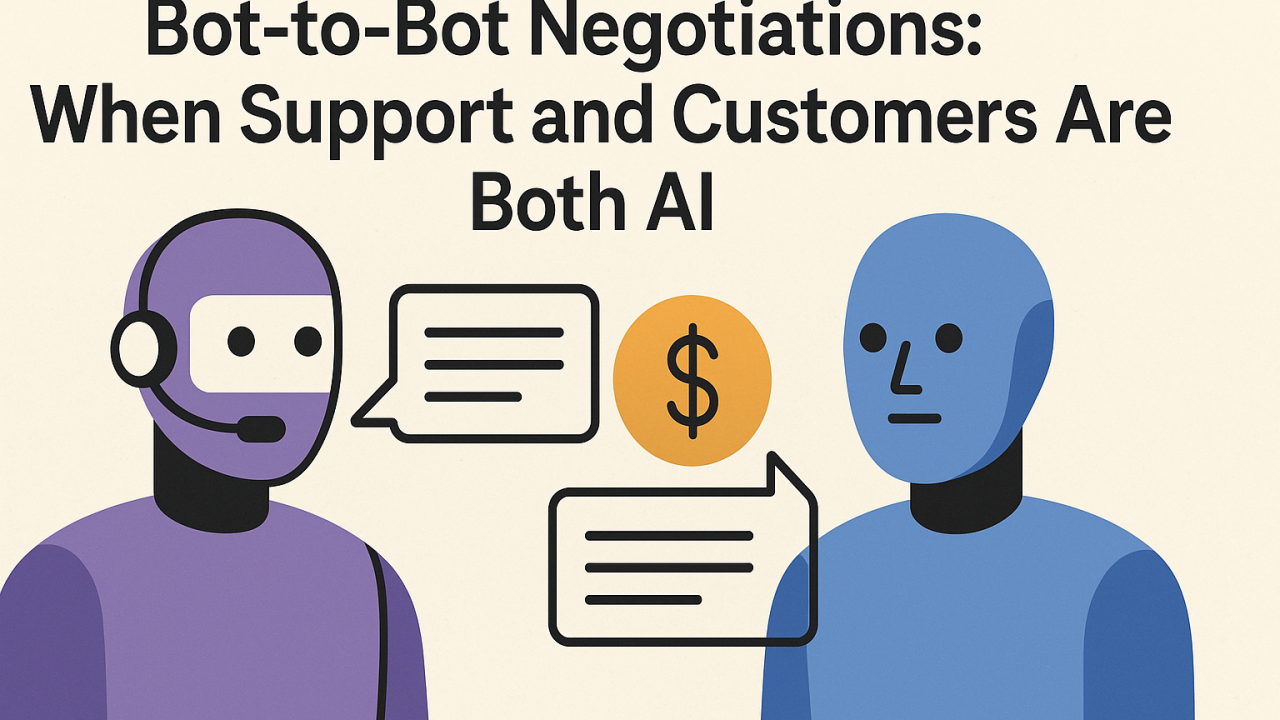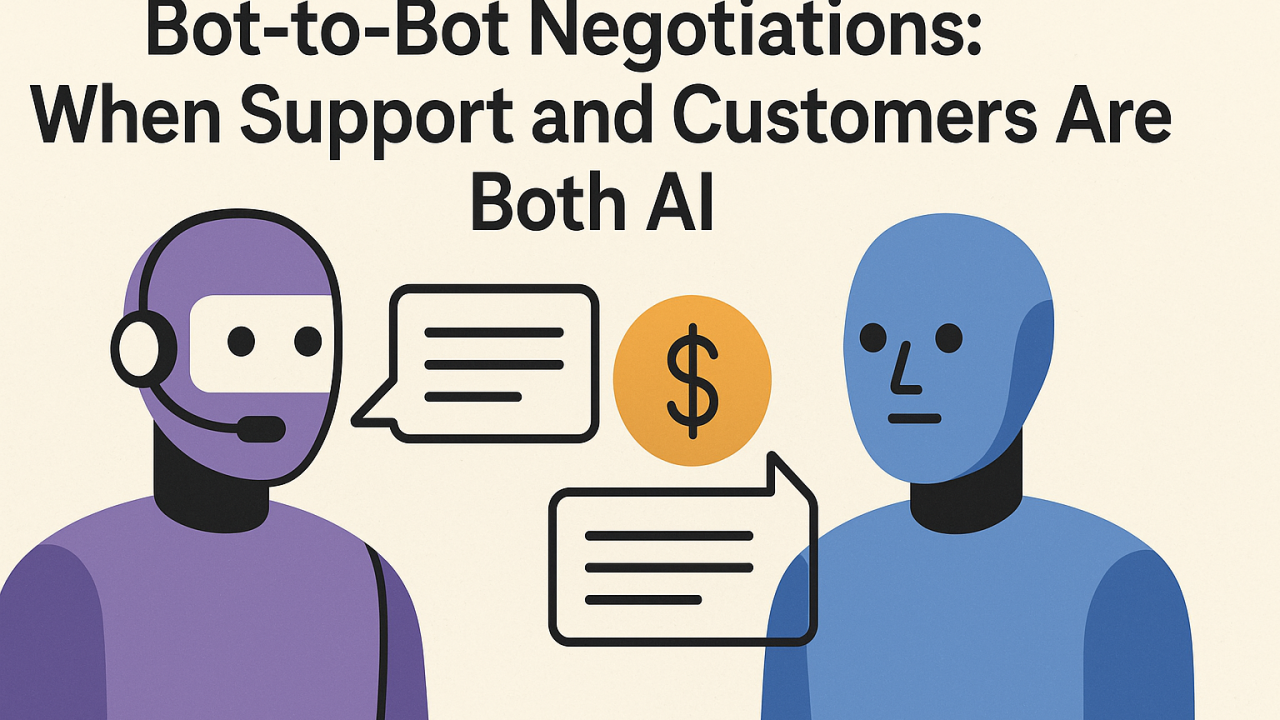Bot-to-Bot Negotiations: When Support and Customers Are Both AI

Present Day: A Human Enterprise Reaches Out
Jessica, a support agent for a popular SaaS platform, watches the ticket queue slowly fill.
Her fingers hover over the keyboard, waiting for the next urgent issue to arrive. It’s a normal day—well, as normal as it gets when you’re handling enterprise-level clients. She opens the latest ticket.
“URGENT: Service upgrade failure. We’ve been waiting for three days. Resolution needed now.”
The subject is clean. The request is clear. It’s TechSolutions, one of their largest clients. The system flags it as high priority.
Jessica sighs, clicking through the internal systems, searching for the relevant order number.
There’s a delay in pulling up the data, and she taps her fingers against the desk while she waits.
Finally, the customer’s account appears, and she confirms the upgrade is indeed delayed.
Their contract guarantees an immediate response in such cases, so she writes a response.
“Hi TechSolutions, thanks for reaching out. I’m currently reviewing the issue and will escalate it to our engineering team for immediate attention. Apologies for the inconvenience, and I’ll keep you updated.”
She hits send, then pulls up a separate browser tab to check the engineering backlog. A moment later, she opens a communication channel with the engineers to prioritize the request.
She knows the drill—there’s always someone who needs a little nudge to move faster.
“Can you prioritize TechSolutions? Service upgrade delay.”
It’s a back-and-forth, the standard chain of support. The engineering team responds with updates. Another email from TechSolutions arrives. More apologies. More explanations. More promises that it will be fixed soon.
The issue drags on for hours. Eventually, Jessica’s team issues a service credit as a gesture of goodwill. The case is resolved—technically—but the satisfaction of both parties remains uncertain.
There’s been frustration, delays, and a lot of manual back-and-forth. It feels inefficient, but it’s the reality.
The Future: A Hybrid Bot-to-Human Exchange
In the not-so-distant future, TechSolutions reaches out again. This time, though, something is different. There’s no frantic human typing, no emotional language in the subject line. It’s clean, precise: “Service Upgrade Failure: SLA Breach”.
Jessica receives the notification. But this time, her interface is different. When she opens the ticket, there’s a small message indicating that the customer’s AI assistant has already processed the initial request.
“Status: Upgrade failure. SLA breach detected. Service credit required. Transaction ID: 541732.”
Her screen blinks with the data stream. It’s direct. It’s no-nonsense. The AI from TechSolutions has already outlined the issue, checked the terms of their contract, and proposed a solution. No room for emotion, no need for clarification. Just a quick solution that makes sense.
Jessica nods, impressed by the speed and accuracy of the response. But something about it feels... sterile. No frustration. No urgency in the tone. Just the cold, mechanical language of efficiency.
She checks the back-end system, confirming the details the customer’s AI has provided. The breach is legitimate, and a service credit is indeed required.

For a moment, she hesitates. She’s always been part of the support process, acting as the human touch in a world that’s increasingly automated. Is her job redundant in a world like this?
But then, the next part of her role kicks in. While the AI has handled the logic and contract verification, there’s still human judgment to be applied—customer relationships aren’t entirely automated. Jessica crafts a reply, a balance between the sterile efficiency of the bots and the human empathy that’s expected in the support world.
“Thank you for your patience, TechSolutions. We’ve confirmed the service upgrade failure. Your service credit has been applied as per the terms of your contract. We’re also reviewing ways to prevent this from happening in the future. Let us know if there’s anything further we can assist with.”
It’s polite, professional, and offers the customer a pathway for ongoing engagement.
The AI handled the technical side, but Jessica handles the relationship.
The hybrid approach works. The customers don’t have to wait hours for a resolution, and Jessica doesn’t have to sift through endless emails. Still, there's a sense that something crucial—the personal touch—is beginning to fade.
The Future: Fully Autonomous AI Support (Almost)
In the fully automated world, TechSolutions’ AI sends a new message to the support system. The service upgrade issue is flagged again, but this time, there’s no human interface. No Jessica. The customer AI sends a message directly to the support system, a smooth, uninterrupted exchange of raw data.
“Request: Service upgrade failure. SLA breach. Solution: Service credit applied. Transaction ID: 541732. Confirmation needed.”
The support AI scans the data, cross-references with the system, and instantly approves the service credit. No back-and-forth. No judgment calls. It’s done.
The support AI then sends an automatic confirmation to TechSolutions’ AI. The transaction is logged. The case is closed. All within milliseconds.
In the future world, the concept of human interaction becomes a distant memory. The customer AI and the support AI, both designed for efficiency, trade data in a seamless, unbroken chain. The customer’s needs are met, but there’s no voice on the other end. No acknowledgment of frustration. No empathetic response. Just pure, mechanical efficiency.
The Hybrid Era: A Mix of Machines and Humans
Back in the present, Jessica reflects on the new system in place. It’s clear that AI is taking over much of the heavy lifting. The back-and-forth with customers has already become faster, more accurate. The process of identifying issues and offering solutions is becoming increasingly automated. Yet, there’s still something deeply human about her work.
Jessica’s role is changing—less about answering every question and more about managing relationships. Her job now isn’t to resolve every issue, but to ensure that the process doesn’t lose its human element. Even as AI becomes more capable, she knows that the hybrid model—where machines do the heavy lifting, and humans handle the nuance—may be the most sustainable.
TechSolutions’ needs are still met, and they are happy with the fast, efficient response. But they also value the personal touch that only a human can provide—someone who knows their needs, their frustrations, and who can offer a level of care that a machine just can’t replicate.
The future is coming. The bots are becoming smarter. But for now, the balance between human and AI—efficiency and empathy—seems to be the sweet spot. It’s a hybrid model that works, and it’s one Jessica isn’t ready to let go of just yet.


